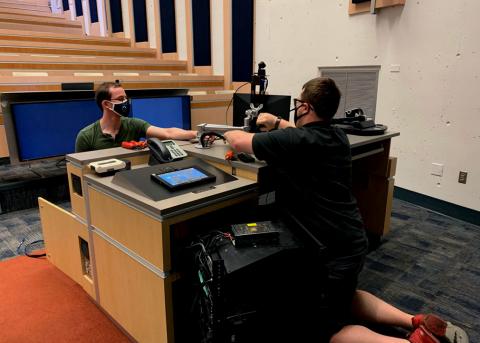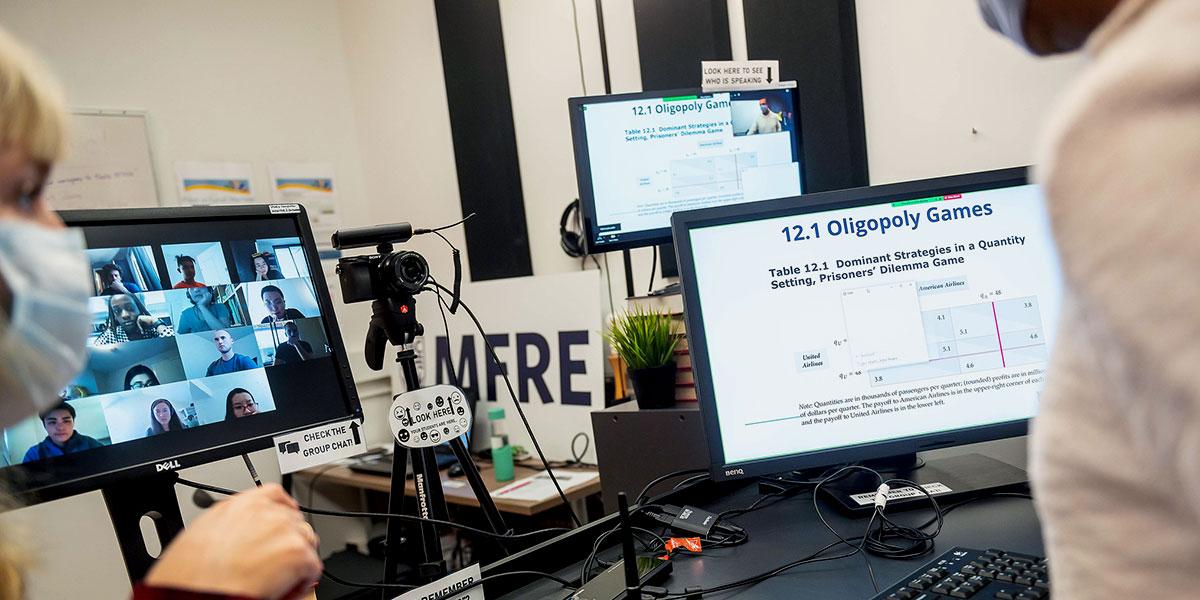How audio visual technology is transforming teaching, learning and working at UBC


This is part three in a series recognizing faculty and staff who are supporting UBC’s transition back to campus. In this update, we recognize the efforts of our colleagues behind UBC IT’s Audio Visual & Creative Services team.

Up until early March 2020, the Audio Visual & Creative Services team under UBC Information Technology (UBC IT) in Vancouver and the Okanagan provided on-site, in-person audio visual (AV) technology support to classrooms, meeting spaces, events and digital signages – any place that required AV technology. And then came the news of the provincial state of emergency due to COVID-19.
There were concerns about how classes would be held in September, and how work would be managed remotely. Garry Der, Manager, Audio Visual Support at UBC Vancouver, recalls, “The Zoom platform is relatively new to UBC. Our team provides primary support for the platform.” Paul Levinsen, Audio Visual Team Lead at UBC Okanagan, adds, “We mastered Zoom quickly and collaborated with teams across the university to create awareness in the community.”
The AV team in Vancouver and the Okanagan not only transitioned faculty and staff to remote working, but also continued to upgrade classroom infrastructure to ensure remote teaching and learning could take place without disruption over the fall.
The nature of the AV team’s work required them to be back on campus sooner than many other teams. “As a result of the journey we were on, we got an opportunity to continuously enhance our procedures and workflows. This prepared us to accommodate the growing requirements coming our way,” recounts Garry. Paul says, “My team adapted very well. We continued to provide in-person support in classrooms and assistance to our colleagues, just in different ways than we did before – through screen sharing via Zoom or Teams.”
Traditionally, the AV team worked on campus-specific projects. The need to respond to the requirements of the community created opportunities for them to streamline their activities and collaborate across both campuses. Paul says, “We created a Teams channel for the AV Help Desk. This helped us troubleshoot and resolve tickets quickly, as well as plan for things coming up.” New ways of working not only resulted in increased collaboration within the AV team across Vancouver and the Okanagan, but also with other units across UBC. Garry says, “I learned so much about the hidden talents and skills of the people I work with through this experience.” Both Paul and Garry agree that this was a positive outcome for their teams.
In-person events that were cancelled were now being held remotely. “We were one of the key groups that supported the two virtual Graduation ceremonies, the launch of the Indigenous Strategic Plan, and the National Anti-Asian Racism Forum, to name a few.” says Garry. In the Okanagan, Paul says, “We continued to provide virtual support – on seminars, student events and UBC Homecoming.”
"As a result of the journey we were on, we got an opportunity to continuously enhance our procedures and workflows. This prepared us to accommodate the growing requirements coming our way."
Garry Der, Manager, Audio Visual Support at UBC Vancouver


The AV team continued to upgrade classrooms to help instructors record their own sessions, but were available to provide on-site support when required. Looking back, Paul says, “Remote working helped people take advantage of some tools that they may not have known were available to them.”
The team has noticed a shift towards a partial self-service model. Colleagues who were previously hesitant about working with technology were now hosting online webinars singlehandedly, by accessing online resources or through remote support, thus making troubleshooting more efficient. Self-service could be the way forward, Garry and Paul feel, and the AV team has developed resources and infrastructure to propel this growing trend. For instance, they have installed recording and streaming equipment, self-deployable kits and auto-tracking cameras in classrooms to support instructors during lessons.
No one knew how long we would be working remotely in March 2020. Although there was limited activity on campus, Paul has noticed a shift in mindsets. He says, “It’s been great to see how people have adapted to technology and are making use of the resources available to them. Now it will be interesting to see what the future of work could look like.” For students, Garry says, “Being able to access remote lessons supports students in quarantine and makes teaching and learning more inclusive.” Paul believes it also supports wellbeing, adding, “Having access to classroom recordings can reduce the burden of missing a lesson in person.”
The AV team has been particularly busy working through spring and summer this year, in preparation for a transition to campus this fall. Some things will look different when we return to campus. For example, some rooms will be equipped and configured to be compatible with Zoom or for recording. A lot of work is being done to test the functionality of these newly added features, and the team is excited to see how their efforts unfold once on-campus activity increases.
Over the last year, the AV team has realized that it’s hard to plan for the future. And although no one knows what the future beholds, the team has learned that continued collaboration with colleagues across the university will help them adapt to the changing needs of the community. The AV team embraced uncertainty once before, and now look to the future with even greater optimism and hope.
Written by Aditi Ghosh, UBC Internal Communications
August 2021
"It’s been great to see how people have adapted to technology and are making use of the resources available to them. Now it will be interesting to see what the future of work could look like."
Paul Levinsen, Audio Visual Team Lead at UBC Okanagan
To date, the AV team in Vancouver is in the process of enhancing up to 165 rooms with recording and live streaming capabilities (up from 40 prior to March 2020) to be fully functional by fall.
Previously, two rooms in the Okanagan had recording features, and this number has gone up to 62.
Find out more about recording and streaming in classrooms.
For more information and resources, visit https://it.ubc.ca/returntocampus.
Other useful links
Find the latest news, updates, events, and useful dates from across UBC, curated for faculty and staff by Internal Communications.
Access a library of resources from multiple UBC websites, all in one place.